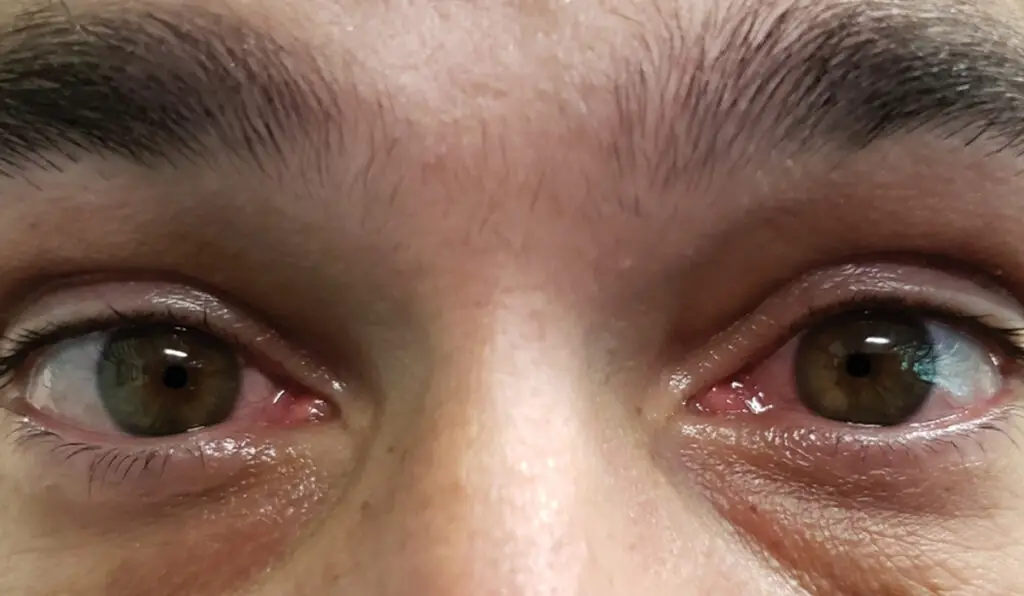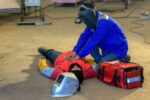Photokeratitis, also known as welder’s flash, is a painful eye condition that can occur when unprotected eyes are exposed to ultraviolet (UV) rays. This condition is known as welder’s flash when it is caused by UV rays from a welding torch. It can feel like you have a “sunburn” on your eyes.
A flash burn is an excruciatingly painful inflammation of the cornea, the clear tissue that covers the front of the eye. All types of UV light can cause it, but welding torches are the most common source.
Flash burns are similar to sunburn and can affect both eyes. Your cornea can heal in one to two days and usually does not leave a scar.
Welding flash is a treatable issue and lasts between 2-3 days. However, if it goes untreated, it may last longer and become more painful.
How do you get a welder’s flash?
When and if the eyes are exposed to a very bright flash of light or extremely bright ultraviolet light, a flash burn occurs. UV light rays are damaging to the skin and the eyes.
When the eyes are exposed to the rays, it causes a flash burn, also known as welders flash. Although ultraviolet from any source can cause a flash burn, it is still most commonly associated with welding torches.
When UV rays damage corneal cells, they flake off, exposing and damaging the nerves beneath the cornea. When a welder’s unprotected eyes are exposed to UV radiation from a welding torch, the resulting welder’s flash feels similar to, but more painful than, a sunburn.
However, photokeratitis does not affect only welders. For example, if you don’t wear protective sunglasses in bright outdoor settings like snow or water, your eyes are at risk. When certain types of broken high-intensity light bulbs are present in some indoor settings, your eyes are also at risk.
How does a welder’s flash affect the cornea?
The sensation of a welder’s flash is similar to that of a sunburn. Instead of the skin, it’s to the eyes in this case. Surprisingly, it can affect either or both eyes. When a welder’s flash occurs, it burns the cornea in your eye, causing redness, irritation, and turning your eyes bloodshot.
Usually, the cornea heals itself in a few days without leaving any scars. However, self-repair is only successful when there is no additional eye strain and the healing process is given adequate time.
However, if the welder’s flash is not treated or constant strain is placed on the eyes, the affected eye is at risk of developing an infection.
Eye infections can be very serious and result in vision loss if not treated medically by a professional as soon as possible.
Symptoms of welder’s flash
Welder’s flash symptoms can appear as soon as 30 minutes after UV exposure. Intense pain in the affected eye is the most common symptom of welder’s flash. If both of your eyes have been damaged by UV rays, you may experience pain in both. (Do Welding Helmets Protect From UV?)
The flash of a welder can also cause photophobia (light sensitivity), resulting in headaches and eye discomfort. This medical eye condition can also give you the impression that you have dirt or debris in your eye when you don’t.
Other symptoms include-
-
-
- Redness in the face
- Redness in the eyelids
- Reduced vision.
- Sensitivity to light
- Irritation
- Dry eyes
- Conjunctivitis
-
Redness and tearing could be caused by wearing contact lenses for an extended period of time or by a reaction to preservatives in eye drops.
Even if you aren’t a welder, your eyes are susceptible to photokeratitis in a variety of circumstances. Individuals who work in the welding industry are more likely to be exposed to welding torches.
However, an individual who is accidentally exposed to a welding arc will experience a welder’s flash due to a lack of personal protective equipment.
These are the symptoms you’re most likely to experience-
-
-
- Watery eyes all the time.
- Experiencing pressure in the affected eye.
- Red bloodshot eyes.
- Redness around the upper eyelid
- Eyes that are swollen.
- The inability to look at various light sources.
- Increased light sensitivity.
-
However, the severity of a flash burn is determined by several factors-
-
-
- Individual’s distance from the ultraviolet source.
- The length of time the eyes were exposed to the light source.
- The angle at which the light source was viewed.
-
These variables will determine how long the welder’s flash lasts. Also, people who work constantly with a welder’s torch should be aware that this type of continuous exposure can cause cataracts, which can lead to vision loss.
How to treat a welder’s flash?
An eye doctor can recommend treatment to help the cornea heal faster after examining your eyes.
However, there are a few things you can do to speed up the healing process. Let’s take a look at some of the treatments for a flash burn:
1.) Dressing
Because some of the common symptoms of a flash burn are eye irritation that leads to the feeling of constant eye rubbing, which can slow-down the healing process, the affected-eye should be covered with padded-dressing to protect from unnecessary light exposure and eye-rubbing.
2.) Using cool packs
Cool packs are very effective at providing symptomatic relief and can be placed over the affected-eye dressing to help reduce swelling.
3.) Dilating drops recommended by your doctor
The use of dilating drops is recommended to relax the eye muscles, which helps to alleviate the constant pain while also allowing the affected eye to rest and heal properly.
4.) Antibiotics
A medical professional may advise you to use antibiotic ointment or drops at home to help prevent the development of an eye infection.
The prescription of a medical professional should be trusted and followed for faster recovery and healing of the affected eye.
5.) Timely review
Timely and proper review by a medical professional is an essential part of the healing process.
The reviewal checkup is critical and should not be overlooked, even if the affected individual believes the eye is healing.
Prevention of welder’s flash
Some very effective treatments can aid in the healing of a flash burn. However, it should be noted that, aside from treatments, one of the best practices is to give your eyes plenty of rest in order for them to heal as quickly as possible.
Treatment of any disease, particularly in a vulnerable part of the body such as the eyes, frequently includes pain and discomfort. As a result, prevention is always advised.
Some of the ways to avoid getting a welder’s flash are as follows:
1.) Wearing protective clothing when working with UV-emitting materials.
2.) You must wear a protective mask when welding.
3.) When welding, always wear safety goggles that have been coated to protect the cornea from UV light.
4.) Buying eyeglasses that meet Health and Safety standards and completely cover the eyes. Sunglasses should provide UVA and UVB protection.
5.) Avoid prolonged exposure to direct sunlight.
FAQs-
Is it possible to go blind as a result of a welder’s flash?
Welders frequently develop welder’s flash, or photokeratitis, a condition caused by prolonged exposure to intense ultraviolet radiation that results in temporary blindness and extreme discomfort when they fail to properly protect their eyes from the arc.
Severe eye injuries can almost always result in permanent blindness.
Why are eye glasses/goggles important while welding?
When on a welding site or about to perform a welding job, coated safety eye goggles should be worn along with a welder’s mask to protect the cornea from ultraviolet rays.
If a person is wearing sunglasses to avoid a flash burn, the sunglasses should protect them from UVB and UV radiation.
Conclusion
Welder’s flash happens when the eyes are exposed to intense ultraviolet light and can be extremely painful. Welders are the most likely to be affected because their work involves working with machinery that emits ultraviolet light.
Personal protective eyewear is required for all welders on the job, especially to protect your eyes from welder’s flash.







